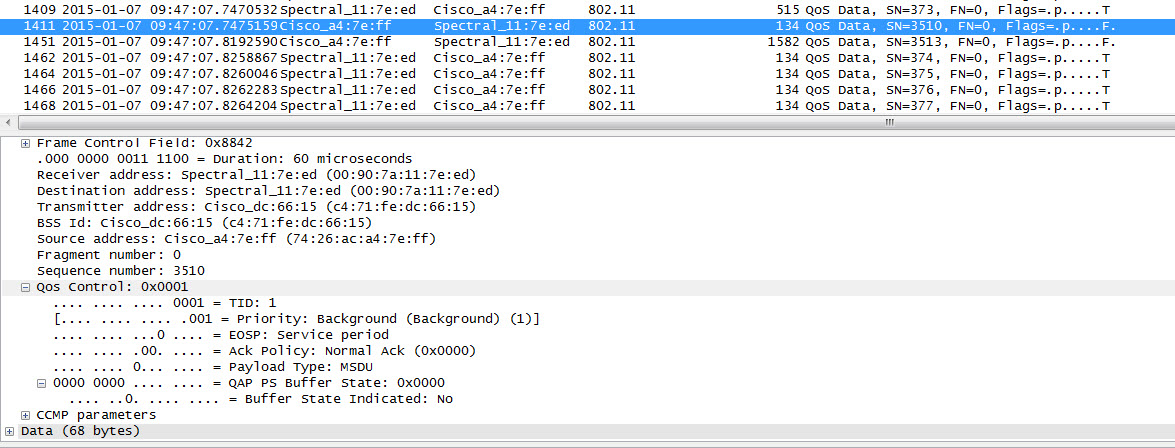- Cisco Community
- Technology and Support
- Wireless - Mobility
- Wireless
- am guessing spectralink would
- Subscribe to RSS Feed
- Mark Topic as New
- Mark Topic as Read
- Float this Topic for Current User
- Bookmark
- Subscribe
- Mute
- Printer Friendly Page
A-MSDU Priorities?
- Mark as New
- Bookmark
- Subscribe
- Mute
- Subscribe to RSS Feed
- Permalink
- Report Inappropriate Content
02-10-2015 07:13 AM - edited 07-05-2021 02:28 AM
Hoping someone in the community can help explain the 802.11n packet aggregation configurable priority values on a Cisco WLC based environment. Do these priority values correlate with QoS (wired and 802.11e values)? If so, if a packet that is tagged background or best effort does that mean in my configuration, packet aggregation will still occur? :
:
802.11n Status:
A-MPDU Tx:
Priority 0............................... Enabled
Priority 1............................... Enabled
Priority 2............................... Enabled
Priority 3............................... Enabled
Priority 4............................... Enabled
Priority 5............................... Enabled
Priority 6............................... Disabled
Priority 7............................... Disabled
Aggregation scheduler.................... Enabled
Frame Burst.............................. Automatic
Realtime Timeout..................... 10
A-MSDU Tx:
Priority 0............................... Enabled
Priority 1............................... Enabled
Priority 2............................... Enabled
Priority 3............................... Enabled
Priority 4............................... Enabled
Priority 5............................... Enabled
Priority 6............................... Disabled
Priority 7............................... Disabled
Rifs Rx ..................................... Enabled
Any insight will be greatly appreciated.
- Labels:
-
Other Wireless Topics
- Mark as New
- Bookmark
- Subscribe
- Mute
- Subscribe to RSS Feed
- Permalink
- Report Inappropriate Content
02-10-2015 08:59 AM
You're going to make me go research this aren't you .. LOL
___________________________________________________________
- Mark as New
- Bookmark
- Subscribe
- Mute
- Subscribe to RSS Feed
- Permalink
- Report Inappropriate Content
02-10-2015 10:37 AM
Yeah but of course! Your too good at it! lol
- Mark as New
- Bookmark
- Subscribe
- Mute
- Subscribe to RSS Feed
- Permalink
- Report Inappropriate Content
02-10-2015 09:11 AM
yes this means aggregation can happen if the STA gains the txop and chooses to send aggregated frames.
- Mark as New
- Bookmark
- Subscribe
- Mute
- Subscribe to RSS Feed
- Permalink
- Report Inappropriate Content
02-10-2015 10:47 AM
Awesome. We are looking to resolve an issue with our Spectralink 8440 VoWLAN handsets. The issue really seems to be similar when we first started rolling out the phones. I have followed the Spectralink VIEW documentation but have only disabled aggregation on Priority 6 and 7 frames. It recommends disabling A-MSDU on all priorities. It looks like packets coming from the wired side are Background or Best effort packets.
If I were to disable MSDU aggregation on all priorities would this significantly impact our data WLANs that support 802.11n?
Also. This issue didn't become apparent until after we configured QoS on the wired network.
Thoughts?
- Mark as New
- Bookmark
- Subscribe
- Mute
- Subscribe to RSS Feed
- Permalink
- Report Inappropriate Content
02-10-2015 11:16 AM
am guessing spectralink would send the data at priority 6 anyways and i doubt for voip traffic the STA will send aggregated frames...do you take a over the air sniff and confirm that.
- Mark as New
- Bookmark
- Subscribe
- Mute
- Subscribe to RSS Feed
- Permalink
- Report Inappropriate Content
02-10-2015 11:33 AM
Yes I do have some OTA captures and it looks like any traffic returning to the Spectralink handset has MSDU values in the frame. Is this the correct assumption. See image:

- Mark as New
- Bookmark
- Subscribe
- Mute
- Subscribe to RSS Feed
- Permalink
- Report Inappropriate Content
02-18-2015 06:55 AM
Anything more on this? I am curious if we follow the Cisco\Spectralink VIEW document by disabling A-MSDU on all priorities would this have any noticeable real-life impact on our other 802.11n clients?
In what scenario does A-MSDU come to being used? We are looking to keep A-MPDU at default (enabled for 0,4,5) and disabling all A-MSDU. Will we notice a major decrease in non-HT 802.11n performance?
- Mark as New
- Bookmark
- Subscribe
- Mute
- Subscribe to RSS Feed
- Permalink
- Report Inappropriate Content
02-10-2015 10:47 AM
Yes,these priority value refer to 802.11e UP values (ie 1,2 - BK, 0,3-BE, 4,5-VI & 6,7-VO). You can enable/disable A-MSDU or A-MPDU for given priority. Refer this link for more detail
http://mrncciew.com/2013/04/11/a-mpdu-a-msdu/
HTH
Rasika
*** Pls rate all useful responses ***
Discover and save your favorite ideas. Come back to expert answers, step-by-step guides, recent topics, and more.
New here? Get started with these tips. How to use Community New member guide


